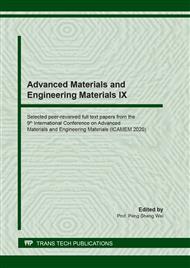p.284
p.289
p.295
p.303
p.309
p.315
p.320
p.327
p.337
One-Step Rapid Synthesis of Al-Based Ag Dendrites for Highly Active and Cost Effective SERS Plasmonic Substrates
Abstract:
Highly active Al-based Ag dendrites SERS plasmonic substrates have been rapidly synthesized by the one-step galvanic displacement reaction without the use of any surfactants and templates. The as-prepared SERS substrates were characterized by scanning electron microscopy (SEM), X-ray diffraction (XRD), and Raman spectroscopy. XRD measurements confirmed the metallic nature of the formed Ag dendrites. None of the organic additives were used in the synthesis process, which ensures the substrates surfaces are completely clean and avoiding the introduction of organic contaminants. The innovative rough bionic substrates yield a final silver dendritic structure that offers large specific surface area and high-density hotspots. Using malachite green as a model target, the Al-based Ag dendrites SERS substrates exhibited acceptable reproducibility (relative standard deviation of 23.8%) and high enhancement capacities (pushed the detection limit down to 10 pM). Importantly, these Ag dendrites could potentially be employed as highly active and cost effective flexible SERS sensors for label-free ultrasensitive detection of biomolecules.
Info:
Periodical:
Pages:
309-314
Citation:
Online since:
September 2020
Authors:
Keywords:
Price:
Сopyright:
© 2020 Trans Tech Publications Ltd. All Rights Reserved
Share:
Citation:


